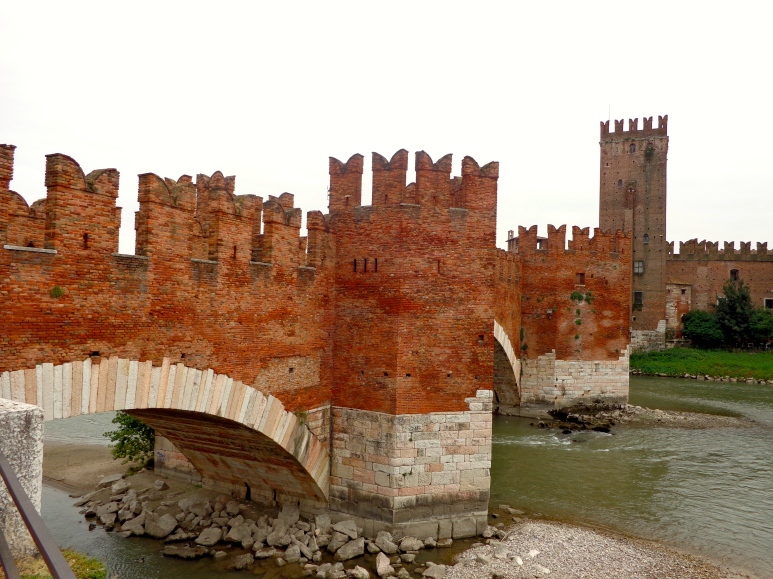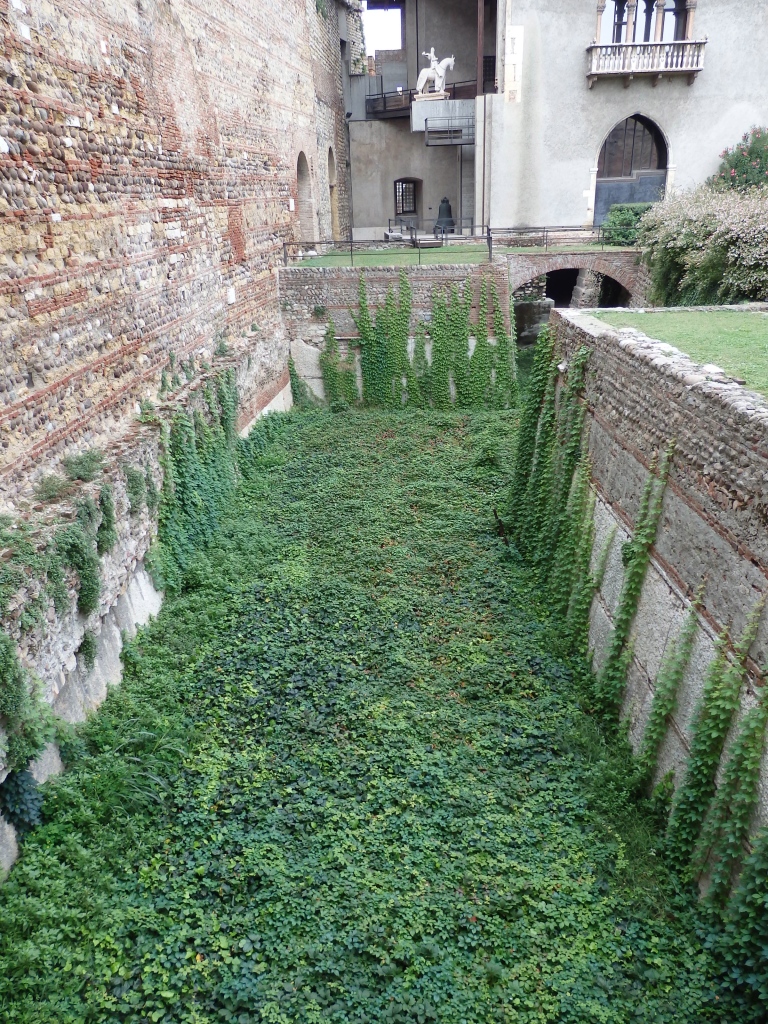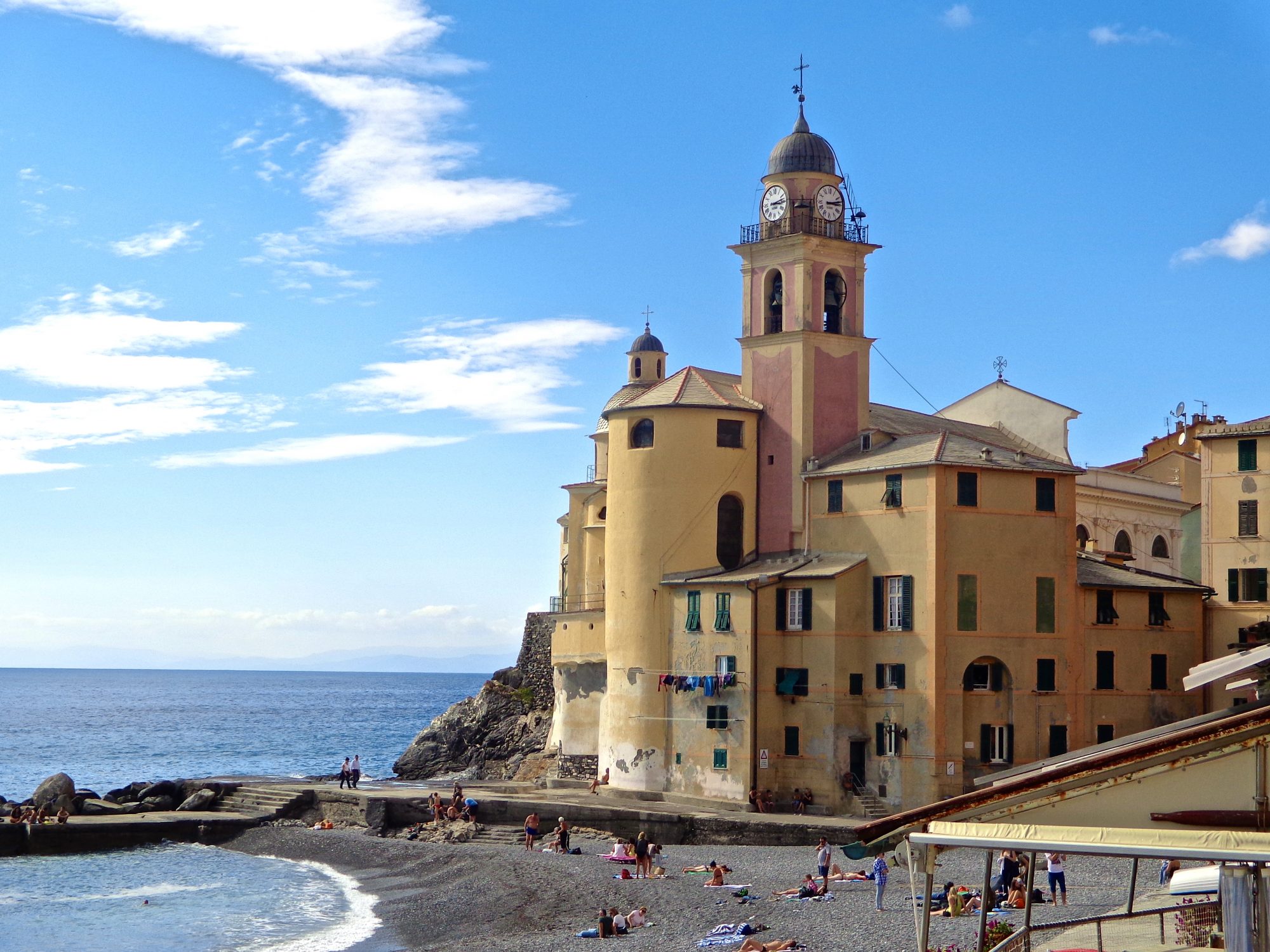
Mystery surrounds Lord Cangrande I (1291 to 1329), early Lord of Verona, like a dark shadow. Historical documents claimed he expired suddenly from polluted drinking water but doubt remained among scholars. Shocking results from a recent exhumation revealed toxic levels of digitalis, a strong poison from the Foxglove family, discovered throughout his liver and colon. It appears that he was likely poisoned under the cloak of medical treatment in the midst of his astounding military victories. One of his physicians was hung afterwards by his successor, Mastino II. Foul play? One would think so.
Lord Cangrande I was the most celebrated of the Scaliger family, the Lords of Verona, who ruled from 1260 to 1387. A noble ruler who was a warrior, prince and patron of Giotto, Dante and Petrarch, he didn’t live to set foot inside Castelvecchio.
Lord Cangrande II della Scala had the castle and bridge built in 1355 for his protection and that of his ruling family. With a reputation opposite that of his predecessor, he was a cruel and tyrannical governor who needed a safe escape route from his abundance of enemies. Venice, the Sforza family and the Gonzaga were a constant threat. He had no lack of forceful neighbors who surrounded his keep in Verona. If needed, the bridge would allow him to escape northwards to relatives in Tyrol.
William Shakespeare was smitten by the walls of Verona and immortalized them through the words of his Romeo ~
“There is no world without Verona walls, but purgatory, torture, hell itself. Hence “banished” is banished from the world. And world’s exile is death.” Romeo and Juliette, Act 3, Scene 3
The Adige River in Verona passes gently beneath the red brick segmental arches of the Scaliger Bridge. Graceful in bearing, it was the world’s largest span at the time of its medieval construction. White marble lines the lower sections of the nearly 49 meter length, which connects to the powerful fortress of Castelvecchio.
The day I visited the Castle was grey and chilly, making this imposing Gothic structure all the more real. As I crossed the bridge toward the castle, I passed striking M-shaped merlons (see in photo above) that ran along the top of the walls. The brickwork opened regularly to offer a view of the river and surrounding countryside. Peace and tranquility permeated the ambience of this visually romantic castle fortress.
According to records, a tiny little church existed on this site prior to the castle’s construction. It’s name, San Martino in Acquaro, was adopted by the castle. It became known as Castello di San Martino in Acquaro. In 1404 it was renamed Castelvecchio, Old Castle, and became part of the Venetian Republic as their military compound.
Seven towers in a pentagonal shape give a magnificent character to the castle, which is divided into four buildings. The super lofty castle keep has four main buildings inside. And, a castle is rarely without a moat that surrounds it.

The castle moat is no longer flowing with water from the Adige River, but is full of lush greenery. Notice the equestrian statue of Cangrande I Della Scala at the top center.
 Equestrian Statue of Cangrande I della Scalla, sandstone sculpture from the early 14th century housed in the Castle museum.
Equestrian Statue of Cangrande I della Scalla, sandstone sculpture from the early 14th century housed in the Castle museum.

The castle remained steeped in historical events. It was brutalized by French troops during the Napoleonic Wars of 1796 when the population reacted violently to the anti-French revolt. During WWII, the retreating Germans destroyed the bridge and tower (Ponte Pietra), which was rebuilt by dredging the river for the original mortar and bricks.
Carlos Scarpa, famous architect of his time, implemented a final restoration of the castle in 1958. Born in Venice, he was an artist very sensitive to historical times. As a result, the Castelvecchio was carefully repaired to its original design.





It is an incredible castle and what an amazing history to go with it. Haven’t been to Verona as yet but will add the castle to my to-see list 😀 Thank you Susan.
LikeLike
I hope you do go to Verona and see this amazing castle! It is always my pleasure to share!!
LikeLike
Castelvecchio is just beautiful!!
LikeLike
Yes it is….thank you!
LikeLike
I had been to Verona years ago and never knew what a treasure like this existed.Upon my return I shall go.The pictures were amazingly sharp and the engineering feat left me speechless. Bravo to you! Vincent Vanasco
LikeLike
Thank you! I was very taken by the whole experience. Do go back and see this amazing castle.
LikeLike
I love Verona and have been a few times, but only discovered the old castle on my last visit. I think it is absolutely stunning. Thanks for all the information.
LikeLike
It is stunning…it caught my entire attention. Especially the M shaped merlons. I found the history fascinating.
LikeLike
How amazingly good this castle still looks. Do you scratch your head and ask how did they achieve such a fabulous piece of engineering work all those hundreds of years ago.
LikeLike
Hi Lyn, yes I constantly do. I know the cathedrals took generations to complete. The engineering is amazing!
LikeLike
I love this post Susan!! What a bful town 🙂 Hope to visit!
LikeLike
Ishita, thank you! You must visit….it is the city of Romeo and Juliette you know:) I found it fascinating, and very beautiful.
LikeLiked by 1 person
Susan, I really enjoyed reading about the intriguing history of this impressive castle. The moat looks wonderful all dressed in living greenery. As always, I love the pictures you included, and I’m glad there have been and continue to be those who have a passion for restoring and preserving historic architecture.
Blessings ~ Wendy ❀
LikeLike
Thank you Wendy. I, too, found the history of this impressive castle to be exciting, as well as the dedication it took to keep it authentic and true to its day. Always my pleasure to share:)
LikeLike
Thank you for this lovely post, Susan. Verona is another of our favourites too. We will always remember visiting one of the ‘lesser’ churches and getting an impromptu private tour by a priest. He had no English, we had virtually no Italian, so in a jumble of French and Italian, he showed us and described all the marvellous wood carving which had been performed by the monks in the making of the interior..
LikeLike
My pleasure! What a wonderful experience you found yourselves in with this priest. And even though you didn’t know each others language, I think you still communicated quite well. Wood carvings by the monks! I would have loved it:)
LikeLike
If I can find my map [suitably annotated] I can send you the location/name of church if you are interested 🙂
LikeLike
If that is not too much trouble, I would be delighted! Thank you…
LikeLike
Susan, I am almost certain the church to which I referred is Chiesa di San Tomaso Cantuariense. It is near the Ponte Nuovo, on the same side of the Adige as the Roman Amphitheatre. Unfortunately I cannot find the map I had scribbled notes on. Being pre-digital camera days, I have no GPS bearing to confirm it :(. Sorry I took so long getting back to you.
LikeLike
No problem…thanks for the information. I will look this church up.
LikeLike
I have never been to Verona and looking at these pictures is inspiring me to go soon 🙂
LikeLike
STUPENDO
LikeLike
Grazie mille!!
LikeLike
How serendipitous….I dreamt of being in Verona just last night
LikeLike
A nice place to be….bet it was romantic!!
LikeLike
Great piece on an interesting place and beautiful city, thanks!
LikeLike
My pleasure…always!
LikeLike
Keep ’em coming!!
LikeLike
Thanks! Will do:)
LikeLike
Lovely piece, I loved the “M-shaped merlon! Thank you for sharing a great piece of history!
LikeLiked by 1 person
Always a pleasure. Yes the merlons were amazing. It was the first thing I noticed about the castle.
LikeLike
Wish I was there! Lovely.
LikeLike
Thank you!
LikeLike
Magnificent!
LikeLike
Thank you!!
LikeLike
Thanks for the fab piece of history! Love Verona!
LikeLike
My pleasure, Diana
LikeLike
Great post!
Nice pictures and lots of information! I really enjoyed it!
Thank you
LikeLike
Thank you Maxine! It greatly impacted me when I learned the history of the castle.
LikeLike